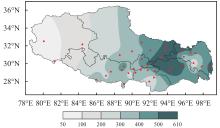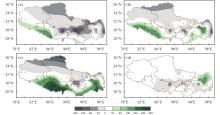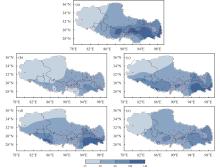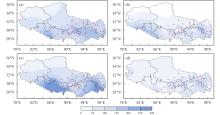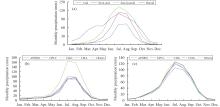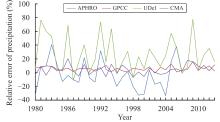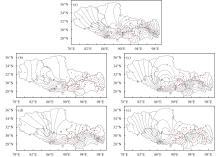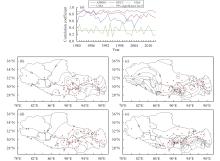Sciences in Cold and Arid Regions ›› 2018, Vol. 10 ›› Issue (5): 392–403.doi: 10.3724/SP.J.1226.2018.00392
Comparison of precipitation products to observations in Tibet during the rainy season
Zhuo Ga1,2,*( ),Za Dui3,Duodian Luozhu3,Jun Du2
),Za Dui3,Duodian Luozhu3,Jun Du2
- 1 Lhasa Branch of Chengdu Institute of Plateau Meteorology, China Meteorological Administration, Lhasa, Tibet 850000, China
2 Tibet Climate Center, Tibet Meteorological Bureau, Lhasa, Tibet 850000, China
3 Lhasa Meteorological Bureau, Lhasa, Tibet 850000, China
| 1 |
Bao XH, Zhang FQ, Sun JH Diurnal variations of warm-season precipitation east of the Tibetan Plateau over China. Monthly Weather Review 2011; 139: 9 2790- 2810.
doi: 10.1175/MWR-D-11-00006.1 |
| 2 |
Chen YL, Chen DH, Li ZC, et al. Preliminary studies on the dynamic prediction method of rainfall-triggered landslide. Journal of Mountain Science 2016; 13: 10 1735- 1745.
doi: 10.1007/s11629-014-3110-5 |
| 3 |
Dai AG, Fung IY, Del Genio AD Surface observed global land precipitation variations during 1900–88. Journal of Climate 1997; 10: 11 2943- 2962.
doi: 10.1175/1520-0442(1997)010<2943:SOGLPV>2.0.CO;2 |
| 4 |
Duan AM, Wu GX Role of the Tibetan Plateau thermal forcing in the summer climate patterns over subtropical Asia. Climate Dynamics 2005; 24: 7–8 793- 807.
doi: 10.1007/s00382-004-0488-8 |
| 5 |
Ensor LA, Robeson SM Statistical characteristics of daily precipitation: comparisons of gridded and point datasets. Journal of Applied Meteorology and Climatology 2008; 47: 9 2468- 2476.
doi: 10.1175/2008JAMC1757.1 |
| 6 |
Groisman PY, Koknaeva VV, Belokrylova TA, et al. Overcoming biases of precipitation measurement: a history of the USSR experience. Bulletin of the American Meteorological Society 1991; 72: 11 1725- 1733.
doi: 10.1175/1520-0477(1991)072<1725:OBOPMA>2.0.CO;2 |
| 7 | Hutchinson MF Interpolation of rainfall data with thin plate smoothing splines — part I: two dimensional smoothing of data with short range correlation. Journal of Geographic Information and Decision Analysis 1998a; 2: 2 139- 151. |
| 8 | Hutchinson MF Interpolation of rainfall data with thin plate smoothing splines — part II: analysis of Topographic dependence. Journal of Geographic Information and Decision Analysis 1998b; 2: 2 152- 167. |
| 9 |
Juárez RIN, Li WH, Fu R, et al. Comparison of precipitation datasets over the tropical south American and African continents. Journal of Hydrometeorology 2009; 10: 1 289- 299.
doi: 10.1175/2008JHM1023.1 |
| 10 |
Karl TR, Quayle RG, Groisman PY Detecting climate variations and change: new challenges for observing and data management systems. Journal of Climate 1993; 6: 8 1481- 1494.
doi: 10.1175/1520-0442(1993)006<1481:DCVACN>2.0.CO;2 |
| 11 |
Kidd C, Dawkins E, Huffman G Comparison of precipitation derived from the ECMWF operational forecast model and satellite precipitation datasets. Journal of Hydrometeorology 2013; 14: 5 1463- 1482.
doi: 10.1175/JHM-D-12-0182.1 |
| 12 |
Klein Tank AMG, Wijngaard JB, Können GP, et al. Daily dataset of 20th-century surface air temperature and precipitation series for the European Climate Assessment. International Journal of Climatology 2002; 22: 12 1441- 1453.
doi: 10.1002/joc.773 |
| 13 |
Legates DR, Willmott CJ Mean seasonal and spatial variability in gauge-corrected, global precipitation. International Journal of Climatology 1990; 10: 2 111- 127.
doi: 10.1002/joc.3370100202 |
| 14 |
Li YQ, Li DJ, Yang S, et al. Characteristics of the precipitation over the eastern edge of the Tibetan Plateau. Meteorology and Atmospheric Physics 2010; 106: 1–2 49- 56.
doi: 10.1007/s00703-009-0048-1 |
| 15 |
Liu Z Evaluation of precipitation climatology derived from TRMM multi-satellite precipitation analysis (TMPA) monthly product over land with two gauge-based products. Climate 2015; 3: 4 964- 982.
doi: 10.3390/cli3040964 |
| 16 |
Long QC, Chen QL, Gui K, et al. A case study of a heavy rain over the southeastern Tibetan Plateau. Atmosphere 2016; 7: 9 118.
doi: 10.3390/atmos7090118 |
| 17 |
Ma YZ, Tang GQ, Long D, et al. Similarity and error intercomparison of the GPM and its predecessor-TRMM multisatellite precipitation analysis using the best available hourly gauge network over the Tibetan Plateau. Remote Sensing 2016; 8: 7 569.
doi: 10.3390/rs8070569 |
| 18 |
Mastyło M Bilinear interpolation theorems and applications. Journal of Functional Analysis 2013; 265: 2 185- 207.
doi: 10.1016/j.jfa.2013.05.001 |
| 19 |
Maussion F, Scherer D, Mölg T, et al. Precipitation seasonality and variability over the Tibetan Plateau as resolved by the high Asia reanalysis. Journal of Climate 2014; 27: 5 1910- 1927.
doi: 10.1175/JCLI-D-13-00282.1 |
| 20 | Schneider U, Becker A, Finger P, et al., 2011. GPCC full data reanalysis version 6.0 at (0.5°, 1.0°, 2.5°): monthly land-surface precipitation from rain-gauges built on GTS-based and historic data. Main, Germany: GPCC, DOI: 10.5676/DWD_GPCC/FD_M_V6_050. |
| 21 |
Şen Z, Habib Z Spatial analysis of monthly precipitation in Turkey. Theoretical and Applied Climatology 2000; 67: 1–2 81- 96.
doi: 10.1007/s007040070017 |
| 22 | Song SY, Wang PX, 2013. Tibet Climate. Beijing: Meteorological Press, pp. 35–73. |
| 23 |
Tong K, Su FG, Yang DQ, et al. Tibetan Plateau precipitation as depicted by gauge observations, reanalyses and satellite retrievals. International Journal of Climatology 2014; 34: 2 265- 285.
doi: 10.1002/joc.3682 |
| 24 |
Wu L, Zhai PM Validation of daily precipitation from two high-resolution satellite precipitation datasets over the Tibetan Plateau and the regions to its east. Acta Meteorologica Sinica 2012; 26: 6 735- 745.
doi: 10.1007/s13351-012-0605-2 |
| 25 | Xiao H Bilinear interpolation parallel algorithm based on GPU computing. Journal of Chinese Computer Systems 2011; 32: 11 2241- 2245. |
| 26 |
Xu Y, Gao XJ, Shen Y, et al. A daily temperature dataset over China and its application in validating a RCM simulation. Advances in Atmospheric Sciences 2009; 26: 4 763- 772.
doi: 10.1007/s00376-009-9029-z |
| 27 |
Yanai M, Li CF, Song ZS Seasonal heating of the Tibetan Plateau and its effects on the evolution of the Asian summer monsoon. Journal of the Meteorological Society of Japan 1992; 70: 1 319- 351.
doi: 10.2151/jmsj1965.70.1B_319 |
| 28 |
Yatagai A, Arakawa O, Kamiguchi K, et al. A 44-year daily gridded precipitation dataset for Asia based on a dense network of rain gauges. Scientific Online Letters on the Atmosphere 2009; 5: 1 137- 140.
doi: 10.2151/sola.2009-035 |
| 29 |
Yatagai A, Kamiguchi K, Arakawa O, et al. APHRODITE: constructing a long-term daily gridded precipitation dataset for Asia based on a dense network of rain gauges. Bulletin of the American Meteorological Society 2012; 93: 9 1401- 1415.
doi: 10.1175/BAMS-D-11-00122.1 |
| 30 | Ye DZ, Gao YX, 1979. The Meteorology of the Qinghai-Xizang (Tibet) Plateau. Beijing: Science Press, pp. 1–278. |
| 31 |
You QL, Kang SC, Pepin N, et al. Relationship between temperature trend magnitude, elevation and mean temperature in the Tibetan Plateau from homogenized surface stations and reanalysis data. Global and Planetary Change 2010; 71: 1–2 124- 133.
doi: 10.1016/j.gloplacha.2010.01.020 |
| 32 |
You QL, Fraedrich K, Ren GY, et al. Inconsistencies of precipitation in the eastern and central Tibetan Plateau between surface adjusted data and reanalysis. Theoretical and Applied Climatology 2012; 109: 3–4 485- 496.
doi: 10.1007/s00704-012-0594-1 |
| 33 |
You QL, Min JZ, Zhang W, et al. Comparison of multiple datasets with gridded precipitation observations over the Tibetan Plateau. Climate Dynamics 2015; 45: 3–4 791- 806.
doi: 10.1007/s00382-014-2310-6 |
| 34 |
Zhang XL, Wang SJ, Zhang JM, et al. Temporal and spatial variability in precipitation trends in the southeast Tibetan Plateau during 1961–2012. Climate of the Past Discussions 2015; 11: 1 447- 487.
doi: 10.5194/cpd-11-447-2015 |
| 35 |
Zhao TB, Fu CB Comparison of products from ERA-40, NCEP-2, and CRU with station data for summer precipitation over China. Advances in Atmospheric Sciences 2006; 23: 4 593- 604.
doi: 10.1007/s00376-006-0593-1 |
| No related articles found! |



